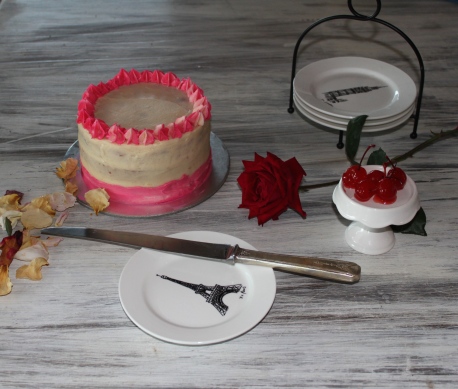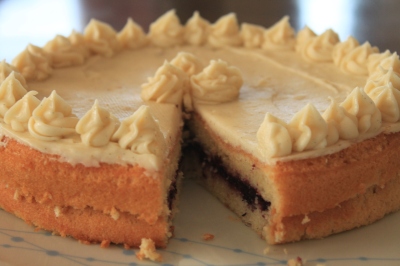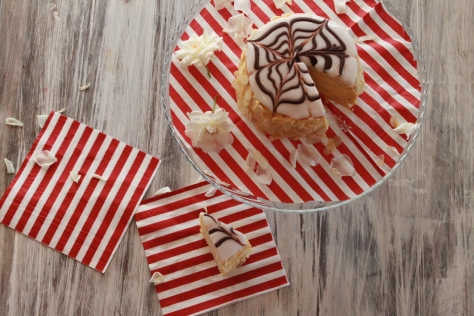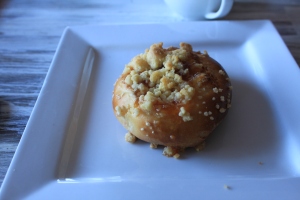It seems that recently this has become daring bakers oriented. This is merely because I’m not finding the time to blog, I’m still baking incessantly. Anyway, this month, I bring to you the june daring bakers challenge:
For the June daring bakers challenge Rebecca from BakeNQuilt.comchallenged us to make Charlotte Royale and Charlotte Russe from scratch. Savory or sweet Charlottes were definitely tasty showstopper.
I chose to do a charlotte royale. A sweet one. Obviously. A caramel and passionfruit swiss roll paired with a caramel bavarian cream. But really, I want to do it all again with more flavours! The possibilities are endless and have definitely got my neurone firing (nerd speak for brainstorming).

Charlotte Royale
Biscuite Roulade
Ingredients
33g sifted cake flour
23g unsifted cornstarch
4 large eggs (room temperature)
room temperature
½ cup plus 1 tablespoon (113g) sugar, divided
¾ teaspoon vanilla
¼ teaspoon cream of tartar
Directions:
Position the oven rack in the lower third of the oven and preheat oven to hot 450°F/230°C/gas mark 8. Grease the jellyroll/sheet pan and line it with parchment and then grease it again and flour it. You may use baking spray with flour included if desired.
In a small bowl, whisk together the cake flour and cornstarch.
Separate 2 of the eggs, placing the yolks in one large mixing bowl and the whites in another.
To the yolks, add the 2 remaining eggs, and ½ cup of the sugar.
Beat the yolk mixture with the paddle attachment on high speed for 5 minutes or until thick, fluffy and tripled in volume. Beat in the vanilla.
Sift ½ the flour mixture over the egg mixture and fold it in gently but rapidly with a large balloon whisk (see notes), slotted skimmer spoon or rubber spatula until the flour has disappeared. Repeat with the remaining flour mixture.
Beat the egg whites with the whisk attachment until foamy, add the cream of tartar and beat until soft peaks form when the beater is raised. Beat in the remaining 1 tablespoon of sugar and beat until stiff peaks form when the beater is raised slowly. Fold the whites into the batter and pour into the prepared pan, using an angled/offset metal spatula to level it.
Bake for 7 minutes or until golden brown, a cake tester comes out clean, and the cake is springy to the touch.
While the cake is still hot, you will need to set aside a piece for the base and roll the remainder in a towel as described below.
Cut off a piece from one of the ends just wide enough to cut the top from later as shown in the photo below. Set this piece aside to cool. After this piece has cooled, cut it with shears or a sharp knife into the circle for the Charlotte base.
While the cake is still hot, roll the remaining piece of cake up tightly in the dishtowel. Roll from the longest side with the darkest side of the cake on the inside. Cool the rolled cake/towel on a rack.
When ready to fill, gently unroll the cake and leave it on top of the towel. Spread up to ½ cup of curd in a thin layer on top of the cooled cake and drizzle with caramel sauce, leaving it on the towel.
Roll up the cake as tightly as you can about 1/3 of the way and then use the towel to pull the roll towards you and press on the other side of the roll with a bench scraper or your hands to help make the roll tight as you continue to use the towel to help roll the cake all the way up. The completed roll should be about 2” (5 cm) in diameter. It is important to get this roll as tight as possible as you do not want gaps in the spirals.
Wrap the roll tightly in plastic wrap and then foil and freeze until firm enough to slice, at least a couple of hours.
Bavarian Cream:
Ingredients
65g sugar
Pinch of salt
1 tablespoon unflavored gelatin powder
3 large egg yolks
400 ml milk
1 vanilla bean, split (you may also use extract/paste, but add it when the cream is cool
240 ml heavy cream
1½ tablespoon (22 ml) butterscotch baileys
Caramel Sauce (to taste)
Directions:
Refrigerate the mixing bowl for whipping the cream.
Have ready a fine strainer nearby, suspended over a small bowl.
whisk together the sugar, salt, gelatin and yolks until well blended, using a wooden spoon or mixer.
In another small saucepan heat the milk and vanilla bean to just below a simmer (170°F/77°C – 180°F/82°C). There will be steam rising off the milk and there may be some small bubbles but it will not be at an active simmer yet. Stir a few tablespoons of hot milk into the yolk mixture to temper it. Gradually add the remaining hot milk and vanilla bean, stirring constantly.
Heat the egg and milk mixture, stirring constantly, to just below a simmer again (170°F/77°C – 180°F/82°C). Steam will begin to appear and the mixture will be slightly thicker than heavy cream. It will leave a well-defined track when a finger is run across the back of a spoon. If the mixture gets too hot (above 180°F/82°C), the cream can curdle. If this happens, immediately pour it into a blender and (with the vent open or a towel over the top) blend it to try to bring it back together smoothly.
Immediately remove from the heat and pour the mixture through the strainer (unless making the orange or lemon variations), scraping up the thickened cream that settles on the bottom of the pan. Remove the vanilla bean and scrape the seeds into the sauce. Stir until the seeds separate.
If time allows, chill the pastry cream in the refrigerator for about 1½ hours (checking frequently and stirring occasionally) until whisk marks barely begin to appear when stirred. For faster results, cool the sauce over an ice-water bath, stirring with a whisk, until whisk marks barely begin to appear. The mixture will start to set around the edges but will still be very liquid.
In the chilled bowl, whip the cream until it mounds softly when dropped from a spoon.
Whisk the Baileys and caramel into the pastry cream and then fold in the whipped cream just until incorporated. The mixture will be soupy, like melted ice cream.
Directions for assembly:
Lightly oil a 6-cup (1½ litre) round bowl or mold (the smaller the diameter at the top the better) and line it as smoothly as possible with plastic wrap, leaving a small overhang. Measure the diameter of the bowl and make note of it. You will need a round cake base of this size for the bottom of the Charlotte. Note: If the diameter of the top of your 6 cup bowl is very wide, you may want to make an additional 1/2 recipe of the cake in a smaller pan to make sure there is enough for the roll as well as the base. Alternately, you can use a smaller bowl.
When the roll is firm, cut it into ¼ inch (5 mm) slices with a small, serrated knife. You want to get as many spirals as possible, so be careful to evenly cut the slices as close to ¼ inch (5 mm) as you can. Work quickly so the cake roll doesn’t thaw and soften too much.
To line the bowl, place 1 slice in the center and place other slices around it as tightly as possible to try to avoid gaps.
Cover the lined bowl tightly and place it in the refrigerator until the filling is ready.
Make the Bavarian cream and spoon it into the lined bowl until it comes up to the top of the bowl or just to the place the top spirals last touch each other. Trim the top spirals even above the cream if necessary.
Place the cake round on top of the cream and touching the edge of the spirals. Press down gently on the edges of the cake circle so it makes contact with the edge of the spirals.
Cover tightly and refrigerate until set, at least 8 hours.
To unmold, invert onto a plate and lift away the bowl, tugging gently on the plastic wrap to release it.


 It’s been a while since we’ve had cake, just for us in the house. By a while I mean like three weeks. Over Easter, hot cross buns were made and chocolate was consumed, but the desire for a nice cake was fulfilled this weekend. I gave
It’s been a while since we’ve had cake, just for us in the house. By a while I mean like three weeks. Over Easter, hot cross buns were made and chocolate was consumed, but the desire for a nice cake was fulfilled this weekend. I gave 




 My mum was reading through some old recipes from her grandmother and decided to try a few out. She chose gingerbread and I chose the vanilla chiffon. There’s something lovely and welcoming about a chiffon cake, soft and light and a good match for a strong fruit filling. So i made a blackberry jam type filling and topped it with a vanilla bean icing. A lovely cake passed down through generations, we shall continue to enjoy it.
My mum was reading through some old recipes from her grandmother and decided to try a few out. She chose gingerbread and I chose the vanilla chiffon. There’s something lovely and welcoming about a chiffon cake, soft and light and a good match for a strong fruit filling. So i made a blackberry jam type filling and topped it with a vanilla bean icing. A lovely cake passed down through generations, we shall continue to enjoy it.

 For the month of January Jelena from
For the month of January Jelena from 






 Happy birthday to my boyfriend! I made
Happy birthday to my boyfriend! I made 










 Cake Ingredients
Cake Ingredients

 Ingredients
Ingredients
